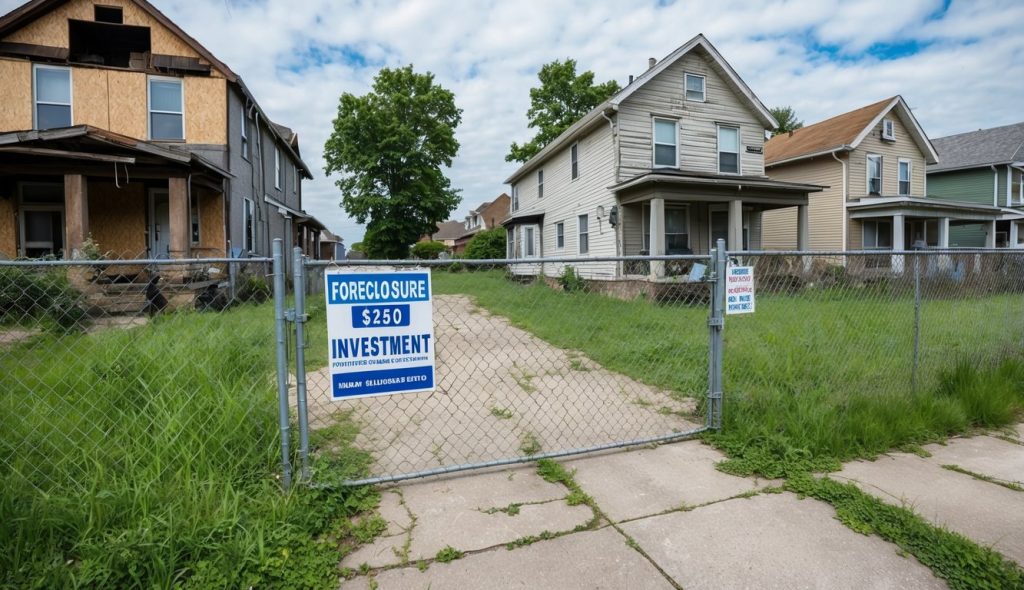Building a successful foreclosure investment business requires strategic planning and precise execution, especially during market shifts. Scaling your real estate portfolio through foreclosed properties can generate substantial returns when you combine discounted purchase prices with effective investment strategies.
Growing your foreclosure investment operations demands more than just capital – it requires building a robust support team and establishing efficient systems. You’ll need to develop relationships with real estate agents, contractors, and financing partners who understand the unique dynamics of foreclosure purchases.
Key Takeaways
- Build a dedicated team of professionals to handle increased deal flow efficiently
- Secure diverse funding sources beyond traditional lending to support rapid growth
- Implement systematic processes for risk management, and evaluating and acquiring distressed properties
Understanding the Foreclosure Market
The real estate foreclosure market offers significant opportunities for investors who know how to navigate its complexities and identify profitable properties. Market success requires deep knowledge of foreclosure stages, legal processes, and current real estate trends.
Different Stages of Foreclosure
Pre-foreclosure begins when the homeowner misses mortgage payments. This stage presents opportunities to negotiate directly with distressed homeowners before the property goes to auction.
Short sales occur when the lender agrees to accept less than the mortgage balance. You can often find better deals during this phase compared to bank-owned properties.
The auction stage happens at the courthouse steps or online. Properties sold at auction require all-cash purchases and often come with no inspection opportunities.
REO (Real Estate Owned) properties are bank-owned after failed auctions. These offer more traditional purchasing processes but typically command higher prices.
Foreclosure Process Overview
The legal foreclosure timeline varies by state and typically starts with a Notice of Default after 3-6 months of missed payments.
The property owner has a redemption period to catch up on payments or negotiate alternatives like loan modifications or short sales.
If no resolution occurs, the property moves to auction. Winning bidders must typically pay in cash within 24 hours.
Key auction requirements:
- Immediate payment availability
- Property research beforehand
- Understanding of local laws
- Title search completion
Impacts of Real Estate Market Trends
Strong markets typically see fewer foreclosures as homeowners can sell before defaulting. Investment opportunities become more competitive during these periods.
Economic downturns increase foreclosure inventory but may signal broader market risks. You must evaluate local employment rates, housing prices, and interest rates.
Property values in surrounding neighborhoods directly affect your potential returns. Research recent sales data and market trends within your target areas.
Rising interest rates can increase foreclosure rates by making refinancing more difficult for struggling homeowners. You may also want to consider commercial foreclosure opportunities.
Acquiring Foreclosed Properties
Successful property acquisition requires knowledge of multiple purchasing channels and strong due diligence processes. Foreclosure investing strategies demand careful research into local markets and property conditions.
Identifying Potential Foreclosure Investments
Start by researching county records and online listing platforms for foreclosure notices. Focus on neighborhoods you understand well and properties that match your investment criteria.
Create a tracking system to monitor pre-foreclosure properties and set up alerts for new listings in your target areas. Pay attention to properties that have been vacant for extended periods.
Perform thorough property inspections when possible. Document visible damage, needed repairs, and potential renovation costs. Research comparable sales to determine accurate after-repair values.
Navigating Foreclosure Auctions
Bidding at foreclosure auctions requires preparation and quick decision-making. Secure financing before the auction date, as most require immediate payment.
Review all available property information and title reports. Be aware that you often cannot inspect the interior before purchase.
Set firm maximum bid amounts based on:
- Estimated repair costs
- Current market values
- Expected holding costs
- Potential resale timeline
Working with Banks and Fannie Mae
Build relationships with REO (Real Estate Owned) departments at local banks. Many offer direct purchase programs for their foreclosed inventory.
Contact Fannie Mae’s HomePath program to access their property listings. Register as an investor to receive notifications about new properties.
Submit strong offers with proof of funds or pre-approved financing. Be prepared to move quickly when opportunities arise.
Consider bulk purchase opportunities if you have substantial capital. Banks sometimes offer discounted packages of multiple properties to experienced investors.
Scaling Your Investment Strategy

Growing your foreclosure investment business requires systematic processes, operational efficiency, and strategic diversification across property types. Successful scaling depends on maximizing returns through effective management and smart renovation decisions.
Effective Property Management
Professional property management teams help maintain consistent cash flow and tenant satisfaction while freeing up your time to focus on growth.
Set up standardized systems for tenant screening, rent collection, and maintenance requests. These processes become crucial as your portfolio expands.
Consider hiring specialized staff or partnering with property management companies once you exceed 10 properties. This delegation enables you to focus on acquiring new properties.
Key Management Tasks:
- Regular property inspections
- Maintenance coordination
- Tenant communication
- Financial reporting
- Legal compliance
Renovation and Value-Add Strategies
Start with small improvements that provide the highest return on investment. Focus on kitchen updates, bathroom modernization, and curb appeal enhancements.
Build relationships with reliable contractors and develop a standardized renovation checklist for each property type. This consistency helps control costs and timeline management.
Priority Renovations:
- Safety upgrades
- Energy efficiency improvements
- Modern appliance installations
- Structural repairs
- Cosmetic updates
Diversifying with Residential and Rental Properties
Mix both short-term flips and long-term rentals in your portfolio to create multiple income streams. This balance provides immediate profits and steady cash flow.
Choose strategic locations with strong rental demand and appreciation potential. Target properties near employment centers, schools, and transportation hubs.
Consider different property types:
- Single-family homes
- Multi-unit buildings
- Condominiums
- Townhouses
Maintain a mix of properties at different price points to reduce market-specific risks and appeal to various tenant segments.
Frequently Asked Questions
Successful foreclosure investing requires mastering key strategies around financing, deal analysis, and systematic growth. These proven methods help investors build sustainable portfolios while minimizing risk.
What strategies are effective for scaling a foreclosure investment business?
You need well-defined systems and repeatable processes to grow efficiently. Start by developing a clear investment plan that outlines your target properties, financing options, and exit strategies.
Focus on building relationships with real estate agents, mortgage lenders, and contractors who specialize in foreclosure properties. Having a reliable team speeds up deal flow.
Leverage technology and automation tools to streamline property analysis, tenant screening, and financial tracking. This allows you to manage more properties without becoming overwhelmed.
How can investors apply the BRRRR method to grow a real estate portfolio efficiently?
The Buy, Rehab, Rent, Refinance, Repeat method helps you recycle capital for continuous growth. Purchase distressed foreclosures below market value and renovate them to increase equity.
Secure quality long-term tenants to establish stable cash flow. Once the property is stabilized, refinance to pull out your initial investment.
Use the recovered capital to repeat the process with additional properties, compounding your portfolio growth over time.
What are the best practices for securing fix and flip loans as a new investor?
Build strong relationships with multiple hard money lenders who specialize in foreclosure deals. They often offer faster closing times than traditional banks.
Prepare detailed scope of work documents and accurate rehab budgets. This demonstrates your competence to lenders.
Start with smaller projects to establish a successful track record before pursuing larger loans.
What is the 2% rule in real estate investing, and how can it be applied to scale a portfolio?
The 2% rule suggests monthly rent should be at least 2% of the purchase price. For example, a $100,000 property should generate $2,000 monthly rent.
This metric helps quickly identify properties with strong cash flow potential. Focus on foreclosures in areas where market rents support this ratio.
How can investors effectively use the snowball method with investment properties?
Start with smaller foreclosures that require minimal repairs. Use profits from these initial deals to fund progressively larger investments.
Reinvest cash flow from each property into property improvements or down payments on additional units.
Build momentum by maintaining strict cost control and maximizing rental income from each acquisition.
What are the challenges in scaling a real estate investment business and how can they be overcome?
Limited access to capital often restricts growth. Combat this by diversifying funding sources through traditional loans, private lenders, and partnerships.
Property management becomes more complex with scale. Implement systems early and consider hiring professional management once you reach 10+ units.
Market competition can make finding deals difficult. Expand your marketing efforts and build a strong network of real estate professionals who bring you off-market opportunities.
Want to know what properties banks are about to list?
Learn how to find deeply discounted properties. Get instant access to pre-foreclosures, REOs, and short sales updated daily!

Master the art of real estate investing with The Real Estate Property Management Guide: Premium Edition – your comprehensive roadmap to successful property management.
Whether you’re a novice investor or seasoned professional, this guide covers everything from selecting the right investment properties to tenant management and property marketing.
The author, Jeff Rohde writing as Jeffrey Roark, is a professional with over 25 years of real estate experience. This Premium Edition includes the valuable bonus book Investment Real Estate Analysis: A Case Study to help you identify hidden opportunities and evaluate properties like a professional.
Learn practical, actionable strategies for both residential and commercial properties, from single-family homes to office buildings and shopping centers.
Don’t just buy property – learn how to manage it successfully and maximize your investment potential.
Grab your copy now from your favorite bookseller:
- Amazon (Basic Edition, does not include Investment Real Estate Analysis: A Case Study)
- Books2Read for Apple, Barnes & Noble, Kobo, Scribed, and 8 more sellers with both eBook and paperback options available ((Premium Edition, includes Investment Real Estate Analysis: A Case Study)
- Payhip as a downloadable PDF (Premium Edition)
Ready to take your business to the next level?
- Subscribe to our newsletter
- Visit the learning center
- Learn more about our consulting services



